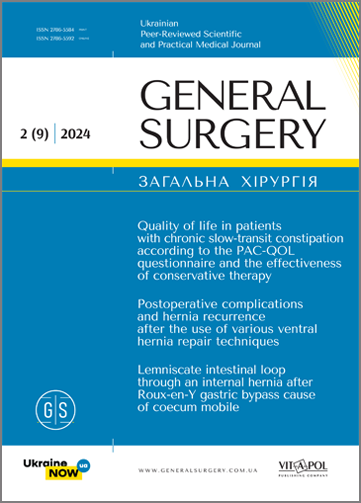Preclinical evaluation of the individualized approach for chronic non-healing wounds management
DOI:
https://doi.org/10.30978/GS-2024-2-54Keywords:
сhronic wound, ulcer, treatment, metal nanooxide, polymer nanofilm, antimicrobial activity, biofilmsAbstract
Chronic non‑healing wounds (CNHW) are very common and often incorrectly treated, the morbidity and associated costs of chronic wounds management highlight the need to implement wound prevention and treatment concepts.
Objective — to evaluate the possibility of different metal nanooxide polymer nanofilms use for CNHW’ local treatment.
Materials and methods. The study design is based on evaluation of various types of dressing materials considering their option for use in CNHW local treatment. Samples of biodegradable polymer films (with an optimal composition of gelatin, polyvinyl alcohol, lactic acid, glycerin and distilled water) saturated with nanoparticles of several oxides with expected antibacterial and pro‑regenerative feature — nZnO, nMgO in concentrations of 1%, 5%, and 10% were used in the study of antimicrobial action and substance release profiling. Quarterly ammonium antiseptic decamethoxin 0.02% was used for control.
Results. Obtained data shows that polymer based biodegradable films incorporating optimal component composition (gelatin, polyvinyl alcohol, lactic acid and glycerin) enriched with 5% and 10% zinc nanooxide have potent antimicrobial activity against both gram‑positive and gram‑negative microorganisms, the most common causative agents of CNHW’s. The ion release capacity analysis showed that the Zinc impregnated wound‑healing biodegradable polymer film gradually releases the active substance in a time dependent manner, and the nano‑sized particles of nanoZinc oxide are released from the polymer composition faster than ordinary zinc oxide.
Conclusions. Complex natural biodegradable polymer based nanofilms are composite materials impregnated with metal nanooxides showing high potential in local treatment of chronic non‑healing wounds. Polymer film with 5% nanoZnO showed up to the 58% higher antimicrobial activity, comparable or exceeding the one of quarterly ammonium compound decamethoxin. Furthermore, nanoZnO impregnated polymer films compared to standard ZnO impregnated polymer films showed up to 63.2% faster substance release profile with rapid and more unified curve.
References
Alam W, Hasson J, Reed M. Clinical approach to chronic wound management in older adults. J Am Geriatr Soc. 2021;69(8):2327- 2334. http://doi.org/10.1111/jgs.17177.
Armstrong DG, Jude EB: The role of matrix metalloproteinases in wound healing. J Am Podiatr Med Assoc. 2002;92(1):12-18.
Bowers S, Franco E. Chronic Wounds: Evaluation and Management. Am Fam Physician. 2020;101(3):159-166.
Cereda E, Klersy C, Serioli M, Crespi A, D’Andrea F. OligoElement Sore Trial Study G: A nutritional formula enriched with arginine, zinc, and antioxidants for the healing of pressure ulcers: a randomized trial. Ann Intern Med. 2015;162(3):167-174. http://doi.org/10.7326/M14-0696.
Cobianch, L, Piccolo D, Dal Mas F, et al. Surgeons’ perspectives on artificial intelligence to support clinical decision-making in trauma and emergency contexts: results from an international survey. World J Emerg Surg. 2023;18(1). https://doi.org/10.1186/s13017-022-00467-3.
Cobianchi L, Dal Mas F, Agnoletti V, et al. Time for a paradigm shift in shared decision-making in trauma and emergency surgery? Results from an international survey. World J Emerg Surg. 2023;18(14). https://doi.org/10.1186/s13017-022-00464-6.
Cobianchi L, Dal Mas F, Massaro M, et al. Diversity and ethics in trauma and acute care surgery teams: results from an international survey. World J Emerg Surg. 2022;17(44). https://doi.org/10.1186/s13017-022-00446-8.
Dumville JC, Webster J, Evans D, Land L. Negative pressure wound therapy for treating pressure ulcers. Cochrane Database Syst Rev. 2015;5:CD011334. http://doi.org/10.1002/14651858.CD011334.pub2.
Giurato L, Meloni M, Izzo V, Uccioli L. Osteomyelitis in diabetic foot: A comprehensive overview. World J Diabetes. 2017;8(4):135-142. http://doi.org/10.4239/wjd.v8.i4.135.
Jarbrink K, Ni G, Sonnergren H, Schmidtchen A, Pang C, Bajpai R, Car J: Prevalence and incidence of chronic wounds and related complications: a protocol for a systematic review. Syst Rev. 2016;5(1):152. http://doi.org/10.1186/s13643-016-0329-y.
Jull AB, Arroll B, Parag V, Waters J: Pentoxifylline for treating venous leg ulcers. Cochrane Database Syst Rev. 2012;12:CD001733. http://doi.org/10.1002/14651858.CD001733.pub3.
Kanellakopoulou K, Thivaios G C, Kolia M, et al. Local treatment of experimental Pseudomonas aeruginosa osteomyelitis with a biodegradable dilactide polymer releasing ciprofloxacin. Antimicrobial agents and chemotherapy. 2008;52(7):2335-2339. http://doi.org/10.1128/AAC.01360-07.
Kumari A, Yadav SK, Yadav SC. Biodegradable polymeric nanoparticles based drug delivery systems. Colloids and surfaces B: biointerfaces. 2010;75(1):1-18. http://doi.org/10.1016/j.colsurfb.2009.09.001.
Niazvand F, Cheshmi A, Zand M, NasrAzadani R, Kumari B, Raza A, Nasibi S. An overview of the development of composites containing Mg and Zn for drug delivery. J Composites Compounds. 2020;2(5):193-204. https://doi.org/10.29252/jcc.2.4.4.
Pavlovich KV, Sydorchuk RI. Injecting material for skin regeneration Lacerta application in treatment of trophic ulcers in patients with diabetic foot syndrome. Klinichna khirurhiia. 2015;7:44-46.
Plehutsa IM, Sydorchuk RI, Plehutsa OM. The systemic immunity cellular link reaction in patients with traumatic illness. Likars’ka sprava. 2015;1-2:26-32.
Polyovyy V, Khorshani Bilel, Sydorchuk R, Kyfiak P, Khomko O, Plehutsa I. The clinically relevant diabetic foot syndrome morphology. J Education, Health and Sport. 2021;11(05): 262-274. http://dx.doi.org/10.12775/34833.
Repchuk Y, Sydorchuk LP, Sydorchuk AR, et al. Linkage of blood pressure, obesity and diabetes mellitus with angiotensinogen gene (AGT 704T > C/rs699) polymorphism in hypertensive patients. Bratisl Lek Listy. 2021;122(10):715-720. http://doi.org/10.4149/BLL_2021_114.
Uccioli L, Izzo V, Meloni M, Vainieri E, Ruotolo V, Giurato L. Nonhealing foot ulcers in diabetic patients: general and local interfering conditions and management options with advanced wound dressings. J Wound Care. 2015;24(suppl. 4):35-42. http://doi.org/10.12968/jowc.2015.24.Sup4b.35.
Venezuela JJD, Johnston S, Dargusch MS. The prospects for biodegradable zinc in wound closure applications. Advanced healthcare materials. 2019;8(16):1900408. http://doi.org/10.1002/adhm.201900408.
Zhang Z, et al. Biodegradable polymers. Handbook of polymer applications in medicine and medical devices. 2014:303-335.
Downloads
Published
How to Cite
Issue
Section
License
Copyright (c) 2024 Authors

This work is licensed under a Creative Commons Attribution-NoDerivatives 4.0 International License.






